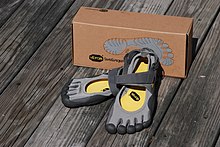Barefoot shoe
Barefoot shoes are shoes that are designed to imitate walking barefoot . The name is an oxymoron , it does not mean that the shoe is worn barefoot or that people walk barefoot with the help of a shoe.
Walk barefoot
The running styles when walking barefoot and walking in sturdy shoes are fundamentally different. While most people in sturdy shoes, especially in those with severe loss, occur on the heel ( heel transition or Heelstrike ) occur experienced barefoot runner with the front foot on ( ball gear or forefoot strike ). The forces acting on the foot are demonstrably lower when walking on the ball. Lieberman's study, however, only refers to the "running" area, not to the "walking" area (which is meant when walking on the ball). There are no scientific studies that prove that the ball of the foot is more natural or that less forces act. However, there are studies that show that the ball walk consumes more energy. Further characteristics of running barefoot are a shorter step length, a higher step frequency and better balance. This is caused by feedback from the body on bumps in the ground, which are perceived by receptors on the sole of the foot .
When walking barefoot, the foot is challenged to adapt to the conditions of the ground. This works the muscles that attach to the toe bones . In closed and tight footwear, the feet are constricted and are therefore passively stressed. Walking barefoot improves blood circulation in the feet, strengthens the foot muscles and promotes healthy and economical walking technique as well as sensorimotor skills and balance .
Properties of barefoot shoes
Barefoot shoes have a particularly thin and flexible sole without a footbed. Due to the thin sole, the structure of the ground becomes more noticeable when walking than with thick soles. Nevertheless, the feet are protected from sharp objects, dirt and moisture by the sole. The weight of barefoot shoes is well below 350 g and enables the wearer to feel like walking barefoot. The trend was picked up in the runner scene and quickly spread. The Nike Free from 2004 is considered the first barefoot shoe , other manufacturers such as Adidas and Asics followed.
Several studies looked at the barefoot shoe and its positive and negative effects. In 2014, the manufacturer Vibram - like other manufacturers - offered buyers compensation for the purchase price because the positive properties from the studies were overinterpreted.
See also
literature
- H. Biedermann: KISS children: causes, (late) consequences and manual therapeutic treatment of early childhood asymmetry . Thieme-Verlag, Stuttgart 2007, ISBN 978-3-13-128853-0 .
- R. Blickhan, G. Kirchner: Biomechanics and motor skills . Verlag Czwalina, Hamburg 1997, ISBN 3-88020-295-8 .
- S. Bruhn: Sensorimotor training and movement coordination . Habilitation thesis, Albert-Ludwigs-Universität Freiburg 2003
- CD Cnyrim: The human stance control with movement stimuli and simultaneous force stimuli . Freiburg 2007
Web links
- Franziska von Treuberg: How healthy is walking barefoot? Prof. Dr. med. Interview with Wessinghage. In: bergzeit.de . August 30, 2014 .
Individual evidence
- ^ Daniel E. Lieberman: Foot strike patterns and collision forces in habitually barefoot versus shod runners. In: Nature 463, January 2012, pp. 531-535.
-
↑ Mick Wilkinson: Walking means rolling - Part 1. In: benimble.info. March 9, 2018, archived from the original on October 7, 2018 ; accessed on May 23, 2019 . Mick Wilkinson: Walking means rolling - Part 2. In: benimble.info. April 6, 2018, archived from the original on October 7, 2018 ; accessed on May 23, 2019 .
- ^ Jenkins, DW Barefoot Running Claims and Controversies. Journal of the American Podiatric Medical Association 101 (3). May / June 2011, pp. 231–246.
- ^ M. Kohler, D. Haritz, V. Diedrichs, M. Fleischhauer, D. Heimann, U. Hinkelmann: Guide to Physiotherapy in Orthopedics and Traumatology. Urban & Fischer Verlag, Munich 2006, p. 311.
- ↑ Barefoot shoes: The trend is so (un) healthy. In: Yahoo . June 19, 2013, accessed May 23, 2019 .
-
↑ Studies on the subject of barefoot shoes: minimal shoes. In: minimalschuhe.de. November 10, 2014, accessed May 23, 2019 . Studies on barefoot shoes and walking barefoot. In: Senmotic-shoes.eu. Retrieved May 23, 2019 . R. Squadrone: Effect of a five-toed minimal protection shoe on static and dynamic ankle position sense. In: The Journal of Sports Medicine and Physical Fitness 51 (3), September 2011, pp. 401-408. S. Curran: Do Vibram Fivefingers really mimic barefoot conditions? A study examining walking efficiency. In: Journal of Foot and Ankle Research 3 (Suppl 1), October 2010, p. 9. Elizabeth E. Miller, Katherine K. Whitcome, Daniel E. Lieberman, Heather L. Norton, Rachael E. Dyer: The effect of minimal shoes on arch structure and intrinsic foot muscle strength. In: Journal of Sport and Health Science 3 (2). June 1, 2014, pp. 74-85 , accessed on May 23, 2019 (English, doi: 10.1016 / j.jshs.2014.03.011 ).
- ↑ Litigation: US manufacturer compensates buyers of barefoot shoes. In: Spiegel Online . May 10, 2014, accessed May 23, 2019 .
